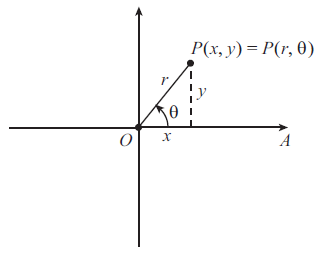Polar Coordinates
Definition
The position of a point in a plane is usually described using Cartesian coordinates. The position of a point $P$ in the plane is described by noting its displacement from the origin in the direction of the $x$ axis, and its displacement from the origin in the direction of the $y$ axis, giving coordinates $(x,y)$.
In polar coordinates, a point $P$ is described by specifying a distance $r$, which is the distance from the origin to the point $P$ along the radius direction, and an angle $\theta$ measured from the horizontal axis anti-clockwise to the line $r$, giving coordinates $(r,\theta)$.

|center
Converting from Cartesian to polar
Suppose we are given the Cartesian coordinates of a point $P=(x,y)$ and want to convert them to polar form. $r$ is the distance from the origin to the point $P$. To find $r$, use Pythagoras' theorem $x^2+y^2=r^2$.
So $r$ is found by: \[r = \sqrt{x^2+y^2}\]
$\theta$ is the angle measured from the axis towards $r$. To find $\theta$, use SOHCAHTOA:
\begin{align} \tan\theta &= \dfrac{O}{A} = \dfrac{y}{x}. \\ \theta &= \tan^{-1} \left(\frac{y}{x}\right) \end{align}
Converting from polar to Cartesian
Using SOHCAHTOA and the trigonometric ratios for sine and cosine, we can find $x$ and $y$.
$\cos\theta= \dfrac{A}{H} = \dfrac{x}{r}$. Rearrange for $x$: \[x = r\cos\theta\]
$\sin\theta= \dfrac{O}{H} = \dfrac{y}{r}$. Rearrange for $y$: \[y = r \sin \theta\]
Worked Examples
Example 1
Find the polar coordinates of the point with Cartesian coordinates $(2,2)$.
Solution
\begin{align} r &= \sqrt{2^2+2^2}\\ &= \sqrt{8}\\ &= 2\sqrt{2} \end{align}
\begin{align} \theta &= \tan^{-1}\left(\frac{2}{2}\right)\\ &= \tan^{-1}(1)\\ &= \frac{\pi}{4} \end{align}
So the polar coordinates are $\left(2\sqrt{2},\dfrac{\pi}{4}\right)$.
Example 2
Find the Cartesian coordinates of the point with polar coordinates $\left(1, \dfrac{3\pi}{4}\right)$.
Solution
\begin{align} x &= 1 \cos \frac{3\pi}{4}\\ &= \cos \frac{3\pi}{4}\\ &= -\frac{1}{\sqrt{2} } \end{align}
\begin{align} y &= 1 \sin \frac{3\pi}{4}\\ &= \sin \frac{3\pi}{4}\\ &= \frac{1}{\sqrt{2} } \end{align}
So the Cartesian coordinates are $\left(-\dfrac{1}{\sqrt{2} },\dfrac{1}{\sqrt{2} }\right)$.
Video Example
Hayley Bishop converts $(1,3)$ to polar coordinates, and $(2,\frac{\pi}{3})$ to Cartesian coordinates.
Workbook
This workbook produced by HELM is a good revision aid, containing key points for revision and many worked examples.
External Resources
- Polar coordinates workbook at mathcentre.